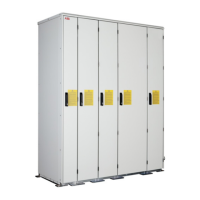The internal cooling circuit 119
Water quality
Freeze protection and corrosion inhibition
Depending on the ambient temperature, add antifreeze and corrosion inhibitor to the
coolant (see Glycol concentration below). If you use one of the following types of
antifreeze that contain both freeze protector and corrosion inhibitor, no additional corrosion
inhibitor is needed:
• Clariant Antifrogen N
• Clariant Antifrogen L
• BASF Glysantin G30
• DOW company Dowcal 20
If you use DOW industrial grade propylene glycol (PGI), add an amount of Cortec VpCI-
649 that makes up 0.5% of the total coolant quantity in the circuit.
Glycol concentration
The graph below shows the required glycol concentration in weight percentage according
to ambient/storage temperature T.
WARNING! Operation at temperatures below 5 °C (41 °F) is not permitted even
with antifreeze.
Note: If more than 25% is added, the pressure loss in the system increases. An operating
pressure of more than 150 kPa is required for sufficient flow.
Tap water
The use of tap water is allowed as follows. Tap water must fulfil the requirements of the Council Directive 98/
83/EC of 3/11/98 on the quality of water intended for human consumption. Corrosion inhibition with 0.5% by
volume Cortec VCI-649 is required.
pH value 6…9
Chloride < 50 mg/l
Sulphate < 100 mg/l
Total dissolved solids < 200 mg/l, no deposits are allowed at the tempera-
ture of +57 °C
Total hardness as CaCO
3
< 250 mg/l
Conductivity < 400 µS/cm (this equals the resistance of > 2500
ohm/cm)
The water must be clean of solid matter.
0
20
40
60
80
-50 -40 -30 -10 0-20
T (°C)
+5
Glycol concentration% (weight)

